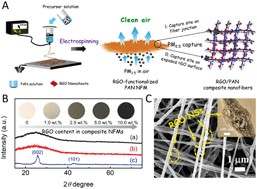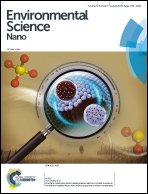RGO-functionalized polymer nanofibrous membrane with exceptional surface activity and ultra-low airflow resistance for PM2.5 filtration†
Abstract
A polar polymer nanofibrous membrane (NFM) made by electrospinning is capable of capturing particulate matter (PM) on the junctions of cross-linked nanofibers through dipole–dipole intermolecular forces. However, the realization of fast and high-efficiency PM2.5 filtration under a high gas-velocity condition is still a big challenge for the pure polymer NFM. Herein, we introduce reduced graphene oxide (rGO) nanosheets (NSs) into the electrospun polyacrylonitrile (PAN) NFM to enhance both the surface activity and the gas permeability of the composite NFM during air filtration. By combining the experimental results with the theoretical calculations, we demonstrate that the rGO NSs dispersed on/in the PAN NFM remarkably increase the PM2.5 capture sites on the uncross-linked nanofibers based on both hydrogen bonding and dipole–dipole interaction forces. Furthermore, the tensile strength of the rGO-functionalized PAN NFM (0.48–1.25 MPa) is much higher than that of the pure PAN NFM (0.19 MPa) due to the excellent mechanical properties of the rGO NSs. The enhanced tensile strength of the composite NFM effectively boosts the gas permeability during air filtration. In this way, the optimal NFM containing 2.5 wt% rGO NSs exhibited >99.9% PM2.5 removal efficiency, ∼0.094 Pa−1 quality factor, and only ∼70 Pa pressure drop for resisting the airflow with a high gas velocity of ∼20 L min−1.



 Please wait while we load your content...
Please wait while we load your content...